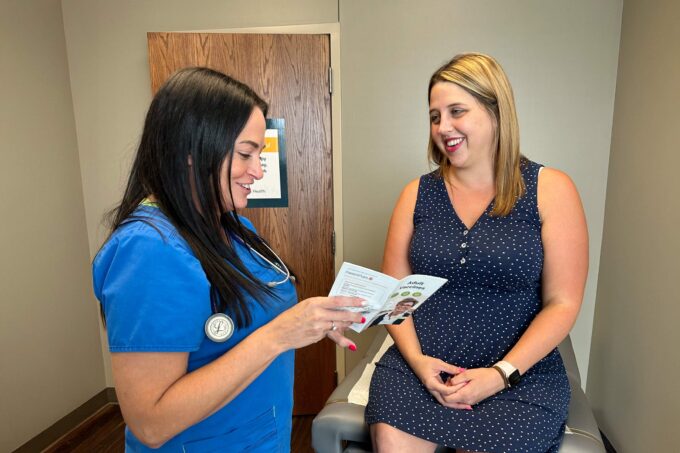- Health Education
- November 22, 2021
Understanding the Different Types of Diabetes and Treatment Options
According to the Centers for Disease Control and Prevention, diabetes is a chronic health condition that affects how your body turns food into energy. Our bodies are designed to break
11 min read

According to the Centers for Disease Control and Prevention, diabetes is a chronic health condition that affects how your body turns food into energy. Our bodies are designed to break down the food we eat into sugar, also known as glucose, which is then released into the bloodstream. When blood sugar goes up, the pancreas is signaled to release insulin. Insulin is a hormone that acts like a key into your body’s cells allowing glucose to enter for use as energy.
One of two things happen if you have diabetes. Either your body does not make enough insulin (type 1) or it can’t use the insulin it does make as well as it should (type 2). When there isn’t enough insulin or when cells stop responding to insulin, known as insulin resistance, too much blood sugar stays in the bloodstream. Over time, too much blood sugar in the bloodstream can cause serious health problems.
There are three types of diabetes:
- Type 1 Diabetes is when the pancreas produces too little insulin or none at all. The body’s own immune system, which typically wards off harmful bacteria and viruses, mistakenly destroys the insulin-producing cells in the pancreas. The exact cause of type 1 is unknown, but genetics or exposure to viruses and other environmental factors may play a role. Type 1 diabetes is most commonly diagnosed in children, teens, and young adults.
- Type 2 Diabetes is when the body becomes insulin resistant over time and is unable to use insulin properly causing blood sugar levels to be too high. 90-95% of those with diabetes have type 2, making it the most common form of diabetes. Unfortunately, as obesity rates rise in children, teens, and young adults, type 2 is no longer considered a disease of adulthood only. Typically, type 2 diabetes can be prevented or delayed through lifestyle changes such as losing weight, eating healthy, and being active.
- Gestational Diabetes develops in pregnant women who have never had diabetes and typically goes away after the baby is born but can increase the risk of the mother developing type 2 diabetes down the road. Gestational diabetes can cause health problems for the unborn baby, including obesity as a child or teen and developing type 2 diabetes.
Prediabetes is also worth mentioning due to some staggering statistics:
- 88 million adults in the U.S. are prediabetic (more than 1 in 3)
- 84% are unaware they even have it
- Blood sugar levels are abnormally high but not high enough to be diagnosed as type 2 diabetes
- Prediabetes raises the risk for type 2 diabetes, heart disease, and stroke
Signs, Symptoms, and Treatment Options
The following are common warning signs for type 1 diabetes that should prompt an immediate appointment with your doctor:
- Loss of weight particularly when there has not been a change in diet or exercise routine
- Frequent urination
- Irritability, confusion, or anxiety
- Blurry vision
- Fruity, sweet breath may be a sign of high ketone levels in the blood
Symptoms may and can develop quickly.
An A1C test, which measures the average amount of glucose in a person’s bloodstream over the past 90 days as a percentage, is a secondary test that can also be used to diagnose type 1 diabetes. An A1C over 6.5% indicates diabetes.
Treatment for type 1 diabetes involves the use of insulin, first and foremost. Dosing and timing are critical factors when administering insulin. Getting regular exercise, eating a balanced, healthy diet with accurate carbohydrate counts, and checking your blood-sugar levels as directed by a doctor are also important in the management of type 1.
Symptoms of type 2 diabetes are often similar to type 1 but, unlike type 1, often come on gradually or there may not be symptoms at all. Prediabetes, on the other hand, typically does not have any clear symptoms and the majority of people with pre-diabetes do not know they even have it. An A1C 5.7-6.4% is considered prediabetic while 6.5% or higher is type 2.
It should be noted, not everyone with prediabetes will progress to type 2 diabetes but the risk is great without lifestyle interventions. Research shows the risk of developing type 2 diabetes can be lowered by as much as 58% by:
- Losing 7% of your body weight (this equates to 13 lbs for a 190 lb person)
- Exercising moderately (a brisk walk for 30 minutes, five days a week)
- Cutting out sugary drinks, such as soda, as well as highly processed foods
Medications specifically designed for type 2 diabetes may be warranted if blood-sugar levels remain high even with lifestyle changes.
Diabetes is a chronic, progressive disease that can be successfully managed with consistent medical follow up, a healthy lifestyle, and early intervention. Bluestem Health has providers experienced in treating diabetes, as well as certified diabetes educators who assist in helping those with diabetes control the disease through exercise, nutrition, medications, and checking blood sugars. Reach out to Bluestem Health for diabetes management needs.
Continue reading

- Health & Wellness
- March 19, 2025
Food Connects Us and Shapes Every Stage of Life
Healthy eating is vital at every stage of life. By making mindful food choices and fostering a culture of healthy eating, you can improve your overall well-being and build a foundation for a healthier future.

- Family Medicine
- March 19, 2025
Comprehensive Family Healthcare: Why Bluestem Health is the Right Choice
At Bluestem Health, we make it easy for you to find the right healthcare provider. We’re here to provide comprehensive family healthcare that fits your needs.

- Family Medicine
- February 18, 2025
Managing Influenza and Other Winter Illnesses
Michael Israel, MD, at Bluestem Health, shares the importance and benefits of timely treatment of winter illnesses for families.
